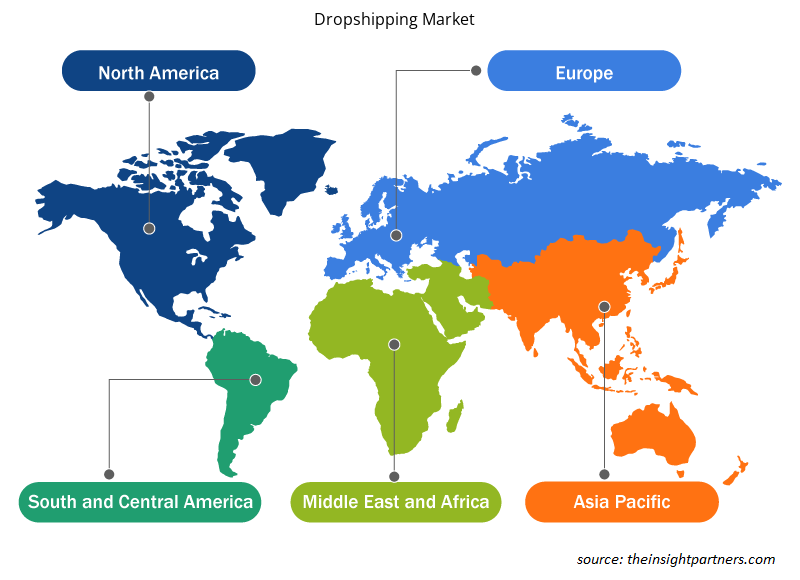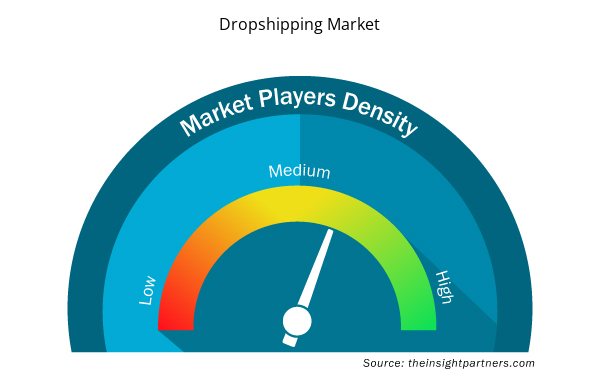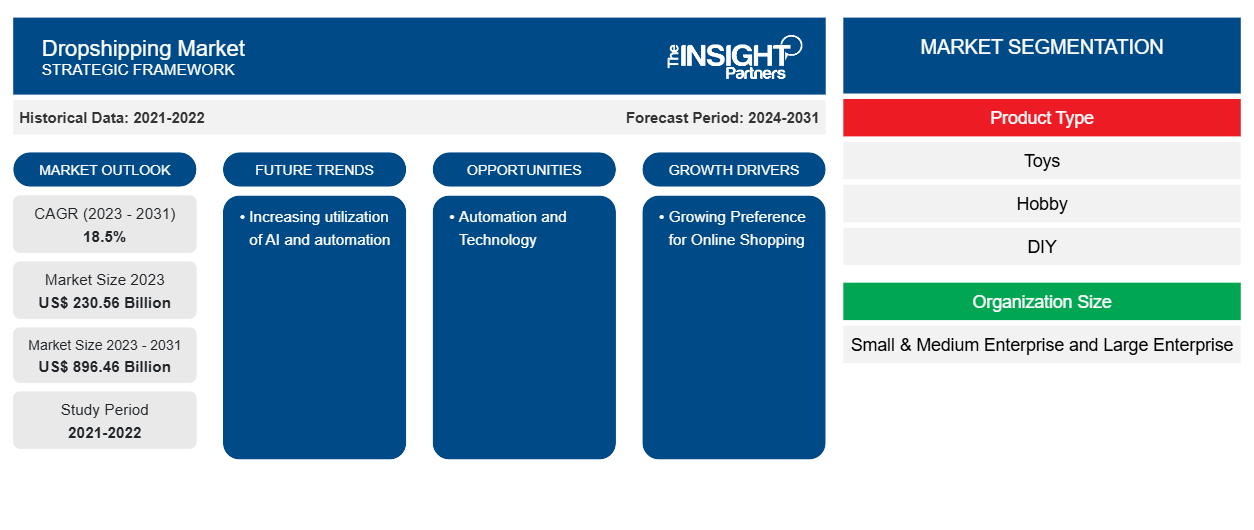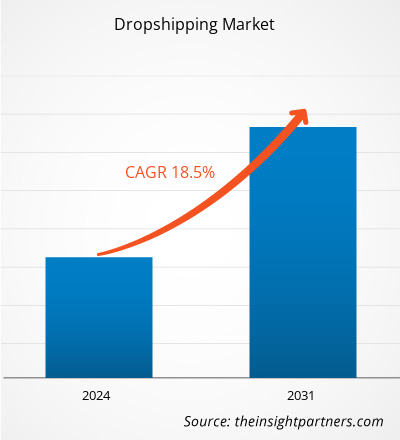Der globale Dropshipping- Markt wird voraussichtlich von 230,56 Milliarden US-Dollar im Jahr 2023 auf 896,46 Milliarden US-Dollar im Jahr 2031 wachsen; von 2023 bis 2031 wird eine durchschnittliche jährliche Wachstumsrate von 18,5 % erwartet. Die zunehmende Nutzung von KI und Automatisierung wird voraussichtlich ein wichtiger Trend im Dropshipping- Markt bleiben .
Dropshipping- Marktanalyse
Der aufstrebende E-Commerce-Sektor hat in den letzten Jahren ein enormes Wachstum erlebt und damit das Dropshipping -Geschäft vorangetrieben. Der Aufstieg der E-Commerce-Branche hat es für Unternehmen einfacher gemacht, Online-Shops einzurichten und einen weltweiten Kundenstamm zu erreichen, was den Dropshipping- Markt vorangetrieben hat .
Dropshipping -Marktübersicht
Dropshipping ist ein Einzelhandelsansatz, bei dem ein Online-Unternehmen seine Artikel nicht auf Lager hält. Wenn ein Verbraucher eine Bestellung aufgibt, sendet das Unternehmen diese stattdessen zusammen mit der Zahlung an einen Dropshipping- Anbieter. Der Lieferant sendet die Waren dann an den Verbraucher . Viele Geschäftsinhaber entscheiden sich für Dropshipping , weil Lieferanten dabei die Auftragsabwicklung übernehmen können. Dies bedeutet, dass Einzelhändler nicht in Lagerraum investieren müssen oder Gefahr laufen, auf nicht verkauften Produkten sitzen zu bleiben. Infolgedessen können Unternehmen mehr Ressourcen für andere Einzelhandelsaktivitäten, einschließlich Marketing, aufwenden.
Passen Sie diesen Bericht Ihren Anforderungen an
Sie erhalten kostenlos individuelle Anpassungen an jedem Bericht, einschließlich Teilen dieses Berichts oder einer Analyse auf Länderebene, eines Excel-Datenpakets sowie tolle Angebote und Rabatte für Start-ups und Universitäten.
- Holen Sie sich die wichtigsten Markttrends aus diesem Bericht.Dieses KOSTENLOSE Beispiel umfasst eine Datenanalyse von Markttrends bis hin zu Schätzungen und Prognosen.
Treiber und Chancen des Dropshipping- Marktes
Wachsende Präferenz für Online-Shopping begünstigt den Markt
E-Commerce verändert die Einzelhandelslandschaft. Die Kaufgewohnheiten der Menschen ändern sich schnell, und der Online-Kauf von Waren wird zum neuen Standard. Diese Expansion wird durch eine Reihe von Ursachen vorangetrieben, darunter die Entwicklung des mobilen Handels, den Aufstieg sozialer Netzwerke und die wachsende Beliebtheit von Abonnementdiensten. Die Länder im asiatisch-pazifischen Raum und in Südamerika verzeichnen derzeit die schnellste Entwicklung im E-Commerce- Sektor. Dies ist sowohl auf die schnelle Einführung neuer Technologien als auch auf die demografische Struktur dieser Länder zurückzuführen, in denen mehr junge als ältere Menschen leben. Diese jüngeren Generationen sind technisch versierter und kaufen lieber online als offline ein.
Automatisierung und Technologie
Dropshipping ist eine Geschäftsstrategie, bei der der Verkäufer keine Waren auf Lager hält, sondern Kundenbestellungen und Versanddaten an den Hersteller, einen anderen Händler oder einen Großhändler sendet, der die Produkte direkt an den Kunden verteilt. Dropshipper profitieren stark von der Automatisierung, da sie die Produktivität verbessert und die Abläufe rationalisiert. Dropshipper können Zeit sparen und den Aufwand minimieren, indem sie viele Bereiche ihres Geschäfts automatisieren, was zu einem effizienteren und profitableren Betrieb führt. Dropshipping- Automatisierungssoftware hilft Dropshippern bei der Automatisierung täglicher Aufgaben, einschließlich der Auftragsweiterleitung an Hersteller, der Bestandsverwaltung und der Versandverfahren.
Dropshipping- Marktbericht – Segmentierungsanalyse
Wichtige Segmente, die zur Ableitung der Dropshipping- Marktanalyse beigetragen haben: Produkttyp und Organisationsgröße.
- Nach Produkttyp ist der Markt in intelligentes Spielzeug, Hobby und Heimwerken, Möbel und Haushaltsgeräte, Lebensmittel und Körperpflege, Elektronik und Medien, Mode und Sonstiges unterteilt. Das Segment Elektronik und Medien hatte im Jahr 2023 einen größeren Marktanteil.
- Basierend auf der Unternehmensgröße ist der Markt in kleine und mittlere Unternehmen sowie Großunternehmen unterteilt. Das Segment der Großunternehmen hatte im Jahr 2023 einen größeren Marktanteil.
Dropshipping -Marktanteilsanalyse nach Geografie
Der geografische Umfang des Dropshipping- Marktberichts ist hauptsächlich in fünf Regionen unterteilt: Nordamerika, Asien-Pazifik, Europa, Naher Osten und Afrika sowie Südamerika/Süd- und Mittelamerika. Nordamerika dominierte den Dropshipping- Markt im Jahr 2023. Der Anstieg des verfügbaren Einkommens der Verbraucher ist einer der Faktoren, die das Wachstum des Dropshipping- Marktes in Nordamerika vorantreiben. Dropshipping bietet Vorteile wie geringere Gemeinkosten und ein breites Produktportfolio, die Einzelhändler anziehen und zum Wachstum des Marktes beitragen.
Regionale Einblicke in den Dropshipping- Markt
Die regionalen Trends und Faktoren, die den Dropshipping- Markt im Prognosezeitraum beeinflussen, wurden von den Analysten von Insight Partners ausführlich erläutert. In diesem Abschnitt werden auch Dropshipping- Marktsegmente und -Geografie in Nordamerika, Europa, im asiatisch-pazifischen Raum, im Nahen Osten und Afrika sowie in Süd- und Mittelamerika erörtert.

- Holen Sie sich die regionalspezifischen Daten für den Dropshipping-Markt
Umfang des Dropshipping-Marktberichts
| Berichtsattribut | Details |
|---|---|
| Marktgröße im Jahr 2023 | 230,56 Milliarden US-Dollar |
| Marktgröße bis 2031 | 896,46 Milliarden US-Dollar |
| Globale CAGR (2023 - 2031) | 18,5 % |
| Historische Daten | 2021-2022 |
| Prognosezeitraum | 2024–2031 |
| Abgedeckte Segmente | Nach Produkttyp
|
| Abgedeckte Regionen und Länder | Nordamerika
|
| Marktführer und wichtige Unternehmensprofile |
|
Marktteilnehmerdichte: Der Einfluss auf die Geschäftsdynamik
Der Dropshipping-Markt wächst rasant, angetrieben durch die steigende Nachfrage der Endnutzer aufgrund von Faktoren wie sich entwickelnden Verbraucherpräferenzen, technologischen Fortschritten und einem größeren Bewusstsein für die Vorteile des Produkts. Mit steigender Nachfrage erweitern Unternehmen ihr Angebot, entwickeln Innovationen, um die Bedürfnisse der Verbraucher zu erfüllen, und nutzen neue Trends, was das Marktwachstum weiter ankurbelt.
Die Marktteilnehmerdichte bezieht sich auf die Verteilung der Firmen oder Unternehmen, die in einem bestimmten Markt oder einer bestimmten Branche tätig sind. Sie gibt an, wie viele Wettbewerber (Marktteilnehmer) in einem bestimmten Marktraum im Verhältnis zu seiner Größe oder seinem gesamten Marktwert präsent sind.
Die wichtigsten auf dem Dropshipping-Markt tätigen Unternehmen sind:
- AliDropship
- Doba Inc.
- Landungszone
- Inventarquelle
- Megagoods, Inc.
- Modalyst, Inc.
Haftungsausschluss : Die oben aufgeführten Unternehmen sind nicht in einer bestimmten Reihenfolge aufgeführt.

- Überblick über die wichtigsten Akteure auf dem Dropshipping-Markt
Neuigkeiten und aktuelle Entwicklungen zum Dropshipping-Markt
Der Dropshipping-Markt wird durch die Erhebung qualitativer und quantitativer Daten nach Primär- und Sekundärforschung bewertet, die wichtige Unternehmensveröffentlichungen, Verbandsdaten und Datenbanken umfasst. Im Folgenden finden Sie eine Liste der Entwicklungen auf dem Markt:
- Im März 2023 brachte ShipStation den ShipStation Dropship Manager auf den Markt, eine neue Lösung, die speziell für Dropship-Manager entwickelt wurde. Dieses Produkt zielt darauf ab, Auftragserfüllungsprozesse zu automatisieren und zu rationalisieren und so Fehler zu reduzieren, die durch manuelles Lieferantenmanagement entstehen. Zu den Kernfunktionen des ShipStation Dropship Managers gehören die Auftragsweiterleitung, Echtzeit-Updates des Auftragsstatus zwischen Dropship-Managern und Lieferanten, Markenverfolgung und die Möglichkeit, eine benutzerdefinierte E-Mail-Domäne für eine verbesserte Kundenbindung zu verwenden. Darüber hinaus können Dropship-Manager ihre Lieferanten einladen, der Plattform beizutreten, was eine schnelle Einarbeitung und einen schnellen Markteintritt ermöglicht.
(Quelle: ShipStation, Pressemitteilung, 2023)
Abdeckung und Ergebnisse des Dropshipping-Marktberichts
Der Bericht „Dropshipping-Marktgröße und -prognose (2021–2031)“ bietet eine detaillierte Analyse des Marktes, die die folgenden Bereiche abdeckt:
- Marktgröße und Prognose auf globaler, regionaler und Länderebene für alle wichtigen Marktsegmente, die im Rahmen des Projekts abgedeckt sind
- Marktdynamik wie Treiber, Beschränkungen und wichtige Chancen
- Wichtige Zukunftstrends
- Detaillierte PEST/Porters Five Forces- und SWOT-Analyse
- Globale und regionale Marktanalyse mit wichtigen Markttrends, wichtigen Akteuren, Vorschriften und aktuellen Marktentwicklungen
- Branchenlandschaft und Wettbewerbsanalyse, einschließlich Marktkonzentration, Heatmap-Analyse, prominenten Akteuren und aktuellen Entwicklungen
- Detaillierte Firmenprofile
- Historische Analyse (2 Jahre), Basisjahr, Prognose (7 Jahre) mit CAGR
- PEST- und SWOT-Analyse
- Marktgröße Wert/Volumen – Global, Regional, Land
- Branche und Wettbewerbsumfeld
- Excel-Datensatz


- Vision Guided Robotics Software Market
- Virtual Pipeline Systems Market
- Truck Refrigeration Market
- Small Internal Combustion Engine Market
- Terahertz Technology Market
- Architecture Software Market
- Aesthetic Medical Devices Market
- Advanced Planning and Scheduling Software Market
- Single-Use Negative Pressure Wound Therapy Devices Market
- Frozen Potato Market

Report Coverage
Revenue forecast, Company Analysis, Industry landscape, Growth factors, and Trends

Segment Covered
This text is related
to segments covered.

Regional Scope
North America, Europe, Asia Pacific, Middle East & Africa, South & Central America

Country Scope
This text is related
to country scope.
Häufig gestellte Fragen
The growing e-commerce market has experienced significant growth in recent years, which in turn is driving the dropshipping market.
The key players holding the majority of shares in global dropshipping are AliDropship, Doba Inc., Dropship Zone, Inventory Source, and Megagoods, Inc.
The global dropshipping market is expected to reach US$ 896.46 billion by 2031.
The dropshipping market size is expected to grow from US$ 230.56 billion in 2023 to US$ 896.46 billion by 2031; it is anticipated to expand at a CAGR of 18.5% from 2024 to 2031.
The increasing utilization of AI and automation is likely to remain a key dropshipping market trends.
Trends and growth analysis reports related to Technology, Media and Telecommunications : READ MORE..
The Insight Partners performs research in 4 major stages: Data Collection & Secondary Research, Primary Research, Data Analysis and Data Triangulation & Final Review.
- Data Collection and Secondary Research:
As a market research and consulting firm operating from a decade, we have published and advised several client across the globe. First step for any study will start with an assessment of currently available data and insights from existing reports. Further, historical and current market information is collected from Investor Presentations, Annual Reports, SEC Filings, etc., and other information related to company’s performance and market positioning are gathered from Paid Databases (Factiva, Hoovers, and Reuters) and various other publications available in public domain.
Several associations trade associates, technical forums, institutes, societies and organization are accessed to gain technical as well as market related insights through their publications such as research papers, blogs and press releases related to the studies are referred to get cues about the market. Further, white papers, journals, magazines, and other news articles published in last 3 years are scrutinized and analyzed to understand the current market trends.
- Primary Research:
The primarily interview analysis comprise of data obtained from industry participants interview and answers to survey questions gathered by in-house primary team.
For primary research, interviews are conducted with industry experts/CEOs/Marketing Managers/VPs/Subject Matter Experts from both demand and supply side to get a 360-degree view of the market. The primary team conducts several interviews based on the complexity of the markets to understand the various market trends and dynamics which makes research more credible and precise.
A typical research interview fulfils the following functions:
- Provides first-hand information on the market size, market trends, growth trends, competitive landscape, and outlook
- Validates and strengthens in-house secondary research findings
- Develops the analysis team’s expertise and market understanding
Primary research involves email interactions and telephone interviews for each market, category, segment, and sub-segment across geographies. The participants who typically take part in such a process include, but are not limited to:
- Industry participants: VPs, business development managers, market intelligence managers and national sales managers
- Outside experts: Valuation experts, research analysts and key opinion leaders specializing in the electronics and semiconductor industry.
Below is the breakup of our primary respondents by company, designation, and region:

Once we receive the confirmation from primary research sources or primary respondents, we finalize the base year market estimation and forecast the data as per the macroeconomic and microeconomic factors assessed during data collection.
- Data Analysis:
Once data is validated through both secondary as well as primary respondents, we finalize the market estimations by hypothesis formulation and factor analysis at regional and country level.
- Macro-Economic Factor Analysis:
We analyse macroeconomic indicators such the gross domestic product (GDP), increase in the demand for goods and services across industries, technological advancement, regional economic growth, governmental policies, the influence of COVID-19, PEST analysis, and other aspects. This analysis aids in setting benchmarks for various nations/regions and approximating market splits. Additionally, the general trend of the aforementioned components aid in determining the market's development possibilities.
- Country Level Data:
Various factors that are especially aligned to the country are taken into account to determine the market size for a certain area and country, including the presence of vendors, such as headquarters and offices, the country's GDP, demand patterns, and industry growth. To comprehend the market dynamics for the nation, a number of growth variables, inhibitors, application areas, and current market trends are researched. The aforementioned elements aid in determining the country's overall market's growth potential.
- Company Profile:
The “Table of Contents” is formulated by listing and analyzing more than 25 - 30 companies operating in the market ecosystem across geographies. However, we profile only 10 companies as a standard practice in our syndicate reports. These 10 companies comprise leading, emerging, and regional players. Nonetheless, our analysis is not restricted to the 10 listed companies, we also analyze other companies present in the market to develop a holistic view and understand the prevailing trends. The “Company Profiles” section in the report covers key facts, business description, products & services, financial information, SWOT analysis, and key developments. The financial information presented is extracted from the annual reports and official documents of the publicly listed companies. Upon collecting the information for the sections of respective companies, we verify them via various primary sources and then compile the data in respective company profiles. The company level information helps us in deriving the base number as well as in forecasting the market size.
- Developing Base Number:
Aggregation of sales statistics (2020-2022) and macro-economic factor, and other secondary and primary research insights are utilized to arrive at base number and related market shares for 2022. The data gaps are identified in this step and relevant market data is analyzed, collected from paid primary interviews or databases. On finalizing the base year market size, forecasts are developed on the basis of macro-economic, industry and market growth factors and company level analysis.
- Data Triangulation and Final Review:
The market findings and base year market size calculations are validated from supply as well as demand side. Demand side validations are based on macro-economic factor analysis and benchmarks for respective regions and countries. In case of supply side validations, revenues of major companies are estimated (in case not available) based on industry benchmark, approximate number of employees, product portfolio, and primary interviews revenues are gathered. Further revenue from target product/service segment is assessed to avoid overshooting of market statistics. In case of heavy deviations between supply and demand side values, all thes steps are repeated to achieve synchronization.
We follow an iterative model, wherein we share our research findings with Subject Matter Experts (SME’s) and Key Opinion Leaders (KOLs) until consensus view of the market is not formulated – this model negates any drastic deviation in the opinions of experts. Only validated and universally acceptable research findings are quoted in our reports.
We have important check points that we use to validate our research findings – which we call – data triangulation, where we validate the information, we generate from secondary sources with primary interviews and then we re-validate with our internal data bases and Subject matter experts. This comprehensive model enables us to deliver high quality, reliable data in shortest possible time.


 Holen Sie sich ein kostenloses Muster für diesen Bericht
Holen Sie sich ein kostenloses Muster für diesen Bericht